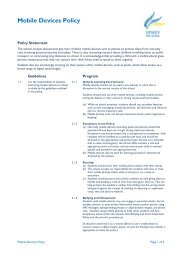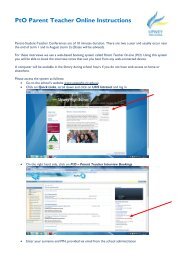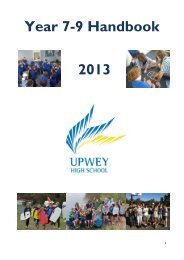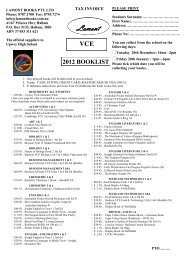First Aid Policy - Upwey High School
First Aid Policy - Upwey High School
First Aid Policy - Upwey High School
Create successful ePaper yourself
Turn your PDF publications into a flip-book with our unique Google optimized e-Paper software.
<strong>First</strong> <strong>Aid</strong> <strong>Policy</strong><br />
5.0 <strong>First</strong> <strong>Aid</strong> Kit Contents<br />
Consistent with the Department’s <strong>First</strong> <strong>Aid</strong> <strong>Policy</strong> and Procedures the school will maintain a <strong>First</strong> <strong>Aid</strong> Kit that includes<br />
the following items:<br />
an up-to-date first aid book. Examples include:<br />
- <strong>First</strong> aid: Responding to Emergencies, Australian Red Cross ;<br />
- Australian <strong>First</strong> <strong>Aid</strong>, St John Ambulance Australia (current edition);<br />
<br />
- Staying Alive, St John Ambulance Australia, (current edition).<br />
wound cleaning equipment<br />
– gauze swabs: 100 of 7.5 cm x 7.5 cm divided into small individual packets of five<br />
– sterile saline ampoules: 12 x 15 ml and 12 x 30 ml<br />
– disposable towels for cleaning dirt from skin surrounding a wound<br />
wound dressing equipment<br />
– sterile, non-adhesive dressings, individually packed: eight 5 cm x 5 cm, four 7.5 m x 7.5 m, four 10 cm x 10 cm for larger<br />
wounds<br />
– combine pads: twelve 10 cm x 10 cm for bleeding wounds<br />
– non-allergenic plain adhesive strips, without antiseptic on the dressing, for smaller cuts and grazes<br />
– steri-strips for holding deep cuts together in preparation for stitching<br />
– non-allergenic paper type tape, width 2.5 cm–5 cm, for attaching dressings<br />
– conforming bandages for attaching dressings in the absence of tape or in the case of extremely sensitive skin<br />
– six sterile eye pads, individually packed<br />
bandages<br />
– four triangular bandages, for slings, pads for bleeding or attaching dressings, splints etc<br />
– conforming bandages: two of 2.5 cm, two of 5 cm, six of 7.5 cm and two of 10 cm. These may be used to hold dressings in<br />
place or for support in the case of soft tissue injuries<br />
• lotions and ointments<br />
– cuts and abrasions should be cleaned initially under running water followed by deeper and more serious wounds being<br />
cleaned with sterile saline prior to dressing. Antiseptics are not recommended<br />
– any sun screen, with a sun protection factor of approximately 15+<br />
– single use sterile saline ampoules for the irrigation of eyes<br />
– creams and lotions, other than those in aqueous or gel form, are not recommended in the first aid treatment of wounds or<br />
burns<br />
asthma equipment (which should be in all major portable kits, camping kits, sports kits etc)<br />
– blue reliever puffer (e.g. Ventolin) that is in date<br />
– spacer device<br />
– alcohol wipes.<br />
Other equipment includes:<br />
single use gloves. These are essential for all kits and should be available for teachers to carry with them, particularly while on yard duty<br />
blood spill kits<br />
vomit spill kits<br />
one medicine measure for use with prescribed medications<br />
disposable cups<br />
one pair of scissors (medium size)<br />
disposable splinter probes and a sharps container for waste<br />
disposable tweezers<br />
one teaspoon<br />
disposable hand towels<br />
pen-like torch, to measure eye-pupil reaction<br />
two gel packs, kept in the refrigerator, for sprains, strains and bruises or disposable ice packs for portable kits<br />
adhesive sanitary pads, as a backup for personal supplies<br />
flexible ‘sam’ splints for fractured limbs (in case of ambulance delay)<br />
additional 7.5 m conforming bandages and safety pins to attach splints<br />
blanket and sheet, including a thermal accident blanket for portable kits<br />
germicidal soap and nail brush for hand-cleaning only<br />
one box of paper tissues<br />
paper towel for wiping up blood spills in conjunction with blood spill kit<br />
single use plastic rubbish bags that can be sealed, for used swabs and a separate waste disposal bin suitable for taking biohazard waste<br />
(Note: Biohazard waste should be burnt and there are several companies that will handle bulk biohazard waste)<br />
ice cream containers or emesis bags for vomit.<br />
6.0 Emergency Telephone Numbers<br />
Poisons Information Service : 13 11 26<br />
Ambulance 000<br />
<strong>First</strong> <strong>Aid</strong> <strong>Policy</strong> Page 8 of 8







